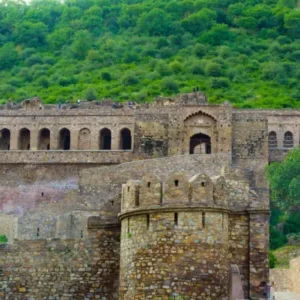Raja Chand constructed the Chand Baori in Abhaneri, one of Rajasthan’s oldest Step wells, in the year 825 AD. Although it appears much deeper from above, the well is just about 20 m deep. There are about 13 twisted, lovely stages, which produce lovely images. The fact that this step well is one of Rajasthan’s deepest step wells is an additional benefit.
The building of the stepwell, which has over 3500 steps, is astounding because no mortars or iron clips are holding the steps together. These procedures have been created to go together without difficulty. The task is flawlessly done. The fact that these steps have lasted over a thousand years in that condition despite earthquakes, cyclones, and even hurricanes is the second most remarkable fact.
As you stand at the top of the stairs for a moment and look down, consider the type of monument this may have been in the past. You can also engage a guide who will be able to educate you on the background and way of life of this Chandi Baori. Witness the magnificent beauty of the stepwell while staying at our resort in Sariska.
The History of Abhaneri Village
Although the stepwell is described in great detail in numerous intricate inscriptions, there are no definitive answers as to why it was ever built. The stepwell once had steps on three sides and a ramp on the fourth, according to the inscriptions. This allowed access to the well and subsequently the water for people and animals of all ages.
Your tour guide will tell you many legends about the opulent festivities that once occurred here and how Mahmud Ghazni’s assault brought the region to its knees. According to local legend, the well was abandoned after the city was taken over and its residents were driven out.

The stepwell was discovered in the 18th century, and its history is equally fascinating. According to folklore, the Lord sent Brahmin minister instructions to find a secret well in a dream. The Brahmin did this and was reinstated as the King’s minister since the King loved the stepwell so much that he even constructed a massive royal castle here (he had been knocked out of favor)
Royal Palace
The palace is just as impressive even though it is not as old as the Chand Baori in Abhaneri. The King used to spend his summers here, but he only came on special occasions. Even while visitors are not allowed inside, the opulent tales of the guide help you imagine the kind of wealth and royalty that once existed outside the walls. Your tour guide will describe how an old water wheel was built via the stepwell to raise water to the level of the palace. The water was then used to make a fountain! With such royal tales, one can’t but wonder what the palace’s original interior looked like.
The Temple
Another wonderful site in Abhaneri is the Vishnu Temple, which is close to the well and the palace. When the King restored the temple, the goddess of Lakshmi, the wife of Lord Vishnu, was allegedly put inside. However, what you will find now is a brilliant marble statue of the goddess rather than the idol the monarch had erected.
While exploring the complex, keep an eye out for the former temple’s remnants, such as pillars and ceiling pieces.
You might see some intriguing and complex sculptures as you enter the temple. These statues show a variety of deities and lords. The level of intricate detailing on these buildings will make you gasp. Here, one may view beautiful artwork that ranges from Krishna carrying a mountain to Ganesha dancing. The three gods, Brahma, Vishnu, and Shiva, are also depicted on a single panel with lifelike characteristics etched into their statues. There are many other sculptures here, so take some time to enjoy the great ability and labor of the sculptors.
You will also be amazed by the sheer volume of ruins and shattered pillars that are piled up on the ground. The reality that the current temple is only a shell of the once-vast and lavish building is further brought home by these fragments. Just wander off and take in the intricately carved pillars; each pillar is decorated with wonderful craftsmanship and colorful accents, and each pillar has a distinctive and individual design.
Additionally, there are carvings of trees, fruits, and plants.
The statues of Lord Agni, Lord Vishnu, and Lord Indra may be seen on the exterior walls of the temple. These deity statues will not only make you feel cozy, but they will also instill a sense of tranquil spirituality in you.
Where is Chand Baori?
The Chand Baori (stepwell) in the village of Abhaneri is one of Rajasthan’s oldest and most popular attractions. King Chanda of the Nikumbha Dynasty constructed it in the ninth century A.D. Chand Baori, one of the world’s largest stepwells, was constructed to conserve water and provide relief from the intense heat.
What makes Chand Baori unique?
King Chanda of the Nikumbha Dynasty constructed it in the ninth century A.D. Chand Baori, one of the world’s largest stepwells, was constructed to conserve water and provide relief from the intense heat. It served as a gathering place for both locals and royals.
Which stepwell is the deepest in the world?
The Chand Baori
Abhaneri, a small village in Rajasthan located near Jaipur, is renowned for its exquisite 1,200-year-old step-well known as the Chand baori. This baori or step-well, which is regarded as the deepest step-well in the world, is situated opposite the partially ruined Harshat Mata mandir temple. While staying at our Resort in Sariska, you can witness the stepwell’s marvellous aesthetic.
How do stepwells get water?
Typically, stepwells consist of two components: a vertical shaft from which water is withdrawn and the surrounding subterranean passageways, chambers, and steps that provide access to the well.
What is India’s oldest stepwell?
Chand Baori is one of the finest examples of ancient India’s geometric expertise. It was constructed in the 9th century in the village of Proficiency. It is believed to be the oldest and deepest stepwell in India, as well as the largest in the world, with the primary function of storing and cooling water.




